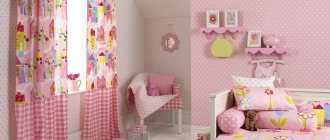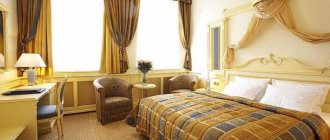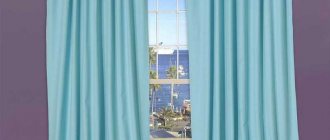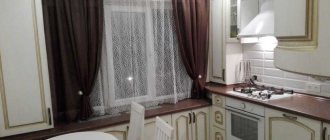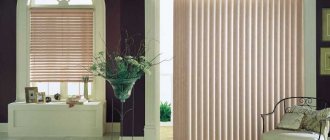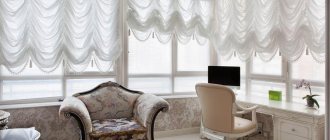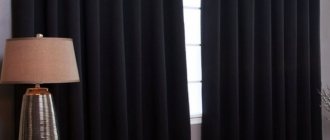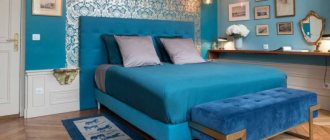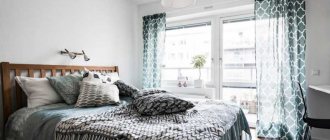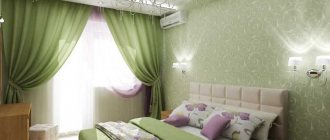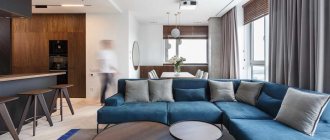Selection rules
Classic style curtains do not tolerate fuss. The design of classic curtains requires preliminary careful measurements and calculations. The choice of paintings must be tailored to each specific window and its size, otherwise the nobility of the finish will lose all meaning.
Wide and tall windows will be gracefully decorated with numerous folds, ruffles, and frills. A smaller room will require less decor.
Small windows will look lovely with curtains in light colors; for a large room you can use richer shades of wine, burgundy, and blue.
The material for classic style curtains can only be natural fabrics. Synthetic fabrics are best left to more modern styles.
Choosing fabric for curtains in a classic design
Among the fabrics that would be appropriate in a classic interior in the form of curtains are velvet, silk, satin, and velor. Of course, modern fabrics have different densities, and the choice of them depends on many parameters. This also includes personal preferences in the design of the room - some prefer to tightly curtain the window openings so that there is no hint of light from the street, while others, on the contrary, prefer that at least some light enter the room instead of a night light.
In addition, it is important to select curtains in accordance with the upholstery of the sofa: velor upholstery with light silk curtains will look quite strange. In any case, in the interior of a living room in a classic style, such nuances should be thought through in advance. Of course, you don't have to choose silk upholstery for a sofa that you use every day, but you can find a more practical alternative with the same shine as silk textiles.
Corduroy curtains look interesting: in harmony with the stripes in the wallpaper, such canvases will emphasize the harmony of a classic English interior. There will be no luxurious details or gilding here - British classics are more restrained and even ascetic.
You can choose the most common tulle for the living room - transparent openwork curtains here are no different from any other interiors where curtains are generally appropriate. The choice of material depends on the budget and requirements for the formation of folds and the softness of the textile.
Signs of classic curtains
The main features of such curtains were and remain the presence of tulle, long opaque panels, the grace of each fold, and sliding panels.
Moreover, the latter can be decorated with tiebacks or used without this decorative element.
Classic curtains
Curtains in the most classic version are long sheets that fall to the floor or barely reach it.
The canvases are complemented by light translucent tulle or delicate organza, slightly gathered into light waves. Such curtains can be gathered at the sides using decorative tiebacks or ties.
How to understand that in front of you are curtains in a classic style
Classic-type curtains can be easily recognized, as they are characterized by several striking features:
- They are made from very expensive materials.
Classic curtains look expensive Source tildacdn.com
- They are usually quite long, reaching to the floor. Their bottom edge may even lie on the floor.
Long curtains Source jaluzityul.ru
- Curtains often have a lambrequin.
Classic curtains with lambrequin Source tildacdn.com
- Presence of curtain fabric.
Curtains with curtains Source opora-stroy.ru
- The curtain is very heavy and massive.
Heavy curtain Source tendaggimagnoni.it
- Curtains have strict geometric proportions.
Geometric curtains Source textil-studio.ru
Curtains, as a rule, are made of heavy material and have vertical folds.
Curtain with folds Source kolinkor.ru
A curtain is a light, weightless transparent or translucent fabric (usually tulle or silk), which is used as a lining for curtains, as if counterbalancing their massiveness and complementing them.
Curtains and curtains Source dekoriko.ru
This curtain adds airiness to the curtain.
Curtain Source topnlist.com
A pelmet is a draped strip of fabric (usually the same material from which the curtain is made) that is attached to the top of the window and runs the entire length of the curtain.
Curtains with lambrequin Source domaletto.ru
He takes on a decorative role. This part of the classic curtain can be equipped with ribbons, tassels, fringe or other elements that perform an aesthetic function.
Decorative lambrequin Source remboo.ru
The lambrequin of classic curtains usually has a flounce-like shape.
Flange-shaped lambrequin Source ecohouse-eg.com
French curtains
Classic French style curtains are complex designs consisting of carefully laid folds, waves, and flounces. Most of all, such curtains are reminiscent of palace interiors or theater halls.
Note!
- Curtains with lambrequin - choice of colors and tones. Features of types of lambrequins. Instructions for sewing lambrequins with your own hands (photo + video)
Greek curtains: TOP 140 photos and video reviews. Choice of material and colors. Features of Greek curtains for different rooms. Installation nuances
Green curtains: features of choosing colors and shades of green. A combination of interior styles with green curtains. Photo and video reviews from designers
Such elements look great on large windows and spacious rooms.
Selection of curtains for the bedroom
Selecting classic curtains for the bedroom requires special attention. The color of the curtains should be attractive and not tire the eye. The darkening of the room should be sufficient for comfortable sleep and rest. It is recommended to choose light colors for the tulle and thick fabrics for the curtains themselves. Can be used as long models if the approach to the window is free. And short, in the presence of nearby furniture.
Please note: “For the bedroom, classic curtains can be chosen in a contrasting design, based on alternating tones of the same color, and then the window area will turn into a compositional center.”
Roman curtains
Roman-style curtains are a panel that forms folds parallel to the floor. When disassembled, they become a flat canvas that can be mounted both above the window opening and on the glass itself.
They look great even in a small room and wonderfully regulate the amount of light entering the room.
Material selection: fabric characteristics
Designer recommendations for choosing textiles for curtains in a classic style:
- Silk fabrics for interior compositions are synthetic materials that imitate the threads of silkworm cocoons. Substitutes are more practical and are not inferior to their analogues in aesthetics. They are easy to wash and iron and shimmer beautifully in sufficient light.
- Satin is a dense silky fabric with a characteristic sheen. Available in a smooth plain fabric or with a blurred pattern.
- Plain curtain jacquard is in many ways reminiscent of satin, but it is a double-sided fabric. On a glossy base there are elegant matte patterns, on the other side - on the contrary, a shiny pattern on a matte basis.
- Curtain velvet is attractive, noble, reminiscent of dress sections with the iridescence of draperies. Velvet curtains for the living room were originally used by the conservative British. It was a multi-layered barrier against the penetration of cold from the window.
- Dense rustling taffeta is used as curtains and is perfectly combined with panels of other textures.
- Curtain brocade and its analogues with metallic threads are a noble chic for eclectic interiors. It is used for stylistic decisions when they want to equip luxury apartments in a palace or oriental style.
Designers often use common textiles for upholstering furniture and draping window openings. Chenille, flock, velor, faux suede - spectacular inserts on an accent wall instead of wallpaper, as in the photo.
As an experiment, each of these materials can be recommended for curtain compositions that are in harmony with the upholstery of the set.
Lambrequin
This decorative element is present in almost all classic curtains.
They decorate the space between the ceiling and the window opening. Such an element is a rather rigid structure, not adjustable in either height or width.
Note!
- Fashionable curtains: TOP-170 photos and video reviews of fashionable curtains. Selection of curtains for different rooms and styles. Fabric and color options
- Beige curtains: features of beige shades, rules for color combinations. Choosing an interior style for beige curtains. Types of fabric materials (photo + video)
Brown curtains: varieties of curtains and curtains. Tips on choosing materials, colors, patterns and sizes of curtains. Brown curtains for different styles (photo + video)
Most often, the lambrequin is made from the same fabric as the main fabric, but sometimes this design becomes a contrasting element of window decoration.
Color spectrum
Curtains can be combined in color with the selected decoration of the room or furniture or become a contrasting element, matched only by the pattern.
Curtains in light colors will visually enlarge the room, warm colors will give it additional comfort, but will take up a little space.
The most popular are curtains of all white shades, beige and sand tones, which are often decorated with darker tiebacks, edgings, fringes, and tassels.
Decorating walls using patterns or designs attracts quite a lot of attention; in this case, the curtains should be plain fabrics. Conversely, the monotony of wallpaper or paint will help to dilute curtains with a light pattern.
Note!
- Turquoise curtains: advantages and disadvantages of turquoise colors. Rules for combining turquoise curtains with interior elements. Selection of fabric materials (photo + video)
Olive curtains: advantages and disadvantages of olive color for curtains. A range of combinations and varieties of shades. Types of olive curtain designs (photo + video)
Curtains for a small kitchen: TOP-140 photos and videos of curtain options for a small kitchen. Tips for choosing length, number of layers, fabric and colors
Curtains with stripes will certainly draw attention to the windows, while the vertical stripes will raise the ceilings.
Choosing curtains for the living room
When choosing classic curtains for the living room, you need to pay attention to the color and width of the fabric. Events are always held in this room and guests gather, so the splendor and beauty of the decoration will be appropriate.
You can use a cornice wider than the window itself, which will visually enlarge the room. Classic curtains in the living room should set off the color scheme of the room. If gold elements are used in the decor, then they can also be added to the window opening. When creating a gothic style, velvet is better. And in a light classic interior you can use silk or satin in light colors.
Material
Classic curtains are characterized by noble fabrics. Most often it is silk, taffeta, satin, brocade, velvet, jacquard. All these fabrics are easy to find in stores. They drape beautifully, shimmer exquisitely in the light, have a pleasant texture, are distinguished by their elegant appearance and long service life.
Use in various rooms
Luxurious French-style folds or a chic lambrequin with simple fabrics are perfect for the living room.
Translucent Austrian curtains can replace tulle, while the main fabrics can be straight and even curtains or have elegant tiebacks.
Curtains for a classic-style bedroom are usually made from delicate fabrics, mostly elegant blue, elegant cream or soft green shades.
The design of curtains in a classic style bedroom involves the use of simple fabrics and translucent tulle or unusual Roman blinds.
Curtains for a classic kitchen are usually presented in light-colored fabrics or the same Roman curtains. They should not block the light.
It is not recommended to use very long curtains and lush folds in the kitchen. Otherwise, the curtains will have to be washed very often.
For the dining room, thicker curtains in beige or olive colors and elegant tulle are suitable.
A luxurious bathroom in a classic style will be perfectly decorated with roller or Roman fabrics, Austrian curtains in light blue or white colors with patterns.
Most often, the color scheme of classic curtains is matched to the living room carpet, bedroom rug, and kitchen facades.
Photos of classic curtains show this perfectly.
Decorative accessories
The beauty of the classic style lies in the luxury and abundance of richness that the details bring. Curtains are decorated with functional accessories, such as:
- Holders made of wood or metal, which are mounted on the wall, hold the shape of the drapery and decorate the curtains. Also, holders can be magnetic, fabric or ribbon.
The photo shows an example of draping curtains and fixing them using holders. The classic mounting height is window sill level.
- The pickups control the light level, are easy to use, and can be changed frequently. They come in the form of hairpins, beads, fabric, ropes. They differ from holders in that they are not attached to the wall.
- Brushes help give the curtains the desired shape and hold it. Also, small tassels can be used to decorate a lambrequin or the edge of a fabric.
- A lambrequin with numerous flaps is suitable for decorating a window in the living room. It may be made of a different material and a contrasting color; in this case, it is important not to overload the room with other decorative elements.
The photo shows an example of how a lambrequin can decorate not only the living room, but also the kitchen.
- In the classic style, fringe decorates the border of the curtains. It can be of different lengths, with beads, bugles and beads, with tassels and weaving.
